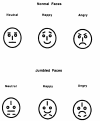Do threatening stimuli draw or hold visual attention in subclinical anxiety?
- PMID: 11757875
- PMCID: PMC1924776
Do threatening stimuli draw or hold visual attention in subclinical anxiety?
Abstract
Biases in information processing undoubtedly play an important role in the maintenance of emotion and emotional disorders. In an attentional cueing paradigm, threat words and angry faces had no advantage over positive or neutral words (or faces) in attracting attention to their own location, even for people who were highly state-anxious. In contrast, the presence of threatening cues (words and faces) had a strong impact on the disengagement of attention. When a threat cue was presented and a target subsequently presented in another location, high state-anxious individuals took longer to detect the target relative to when either a positive or a neutral cue was presented. It is concluded that threat-related stimuli affect attentional dwell time and the disengage component of attention, leaving the question of whether threat stimuli affect the shift component of attention open to debate.
Figures
References
-
- Aristotle, Lawson-Tancred H. The art of rhetoric. London: Penguin Classics; 1991.
-
- Armony JL, LeDoux JE. How danger is encoded: Towards a systems, cellular, and computational understanding of cognitive-emotional interactions in fear. In: Gazzaniga MS, editor. The new cognitive neurosciences. 2nd ed. Boston: MIT Press; 2000. pp. 1067–1079.
-
- Aronoff J, Barclay AM, Stevenson LA. The recognition of threatening facial stimuli. Journal of Personality and Social Psychology. 1988;54:647–655. - PubMed
-
- Beck AT. Cognitive therapy and the emotional disorders. New York: International Universities Press; 1976.
-
- Beck AT, Ward CH, Mendelson M, Mock J, Erbaugh J. An inventory for measuring depression. Archives of General Psychiatry. 1961;4:561–571. - PubMed



